The Australian health ministries
VerifiedAdded on 2022/09/14
|8
|2169
|13
AI Summary
Contribute Materials
Your contribution can guide someone’s learning journey. Share your
documents today.
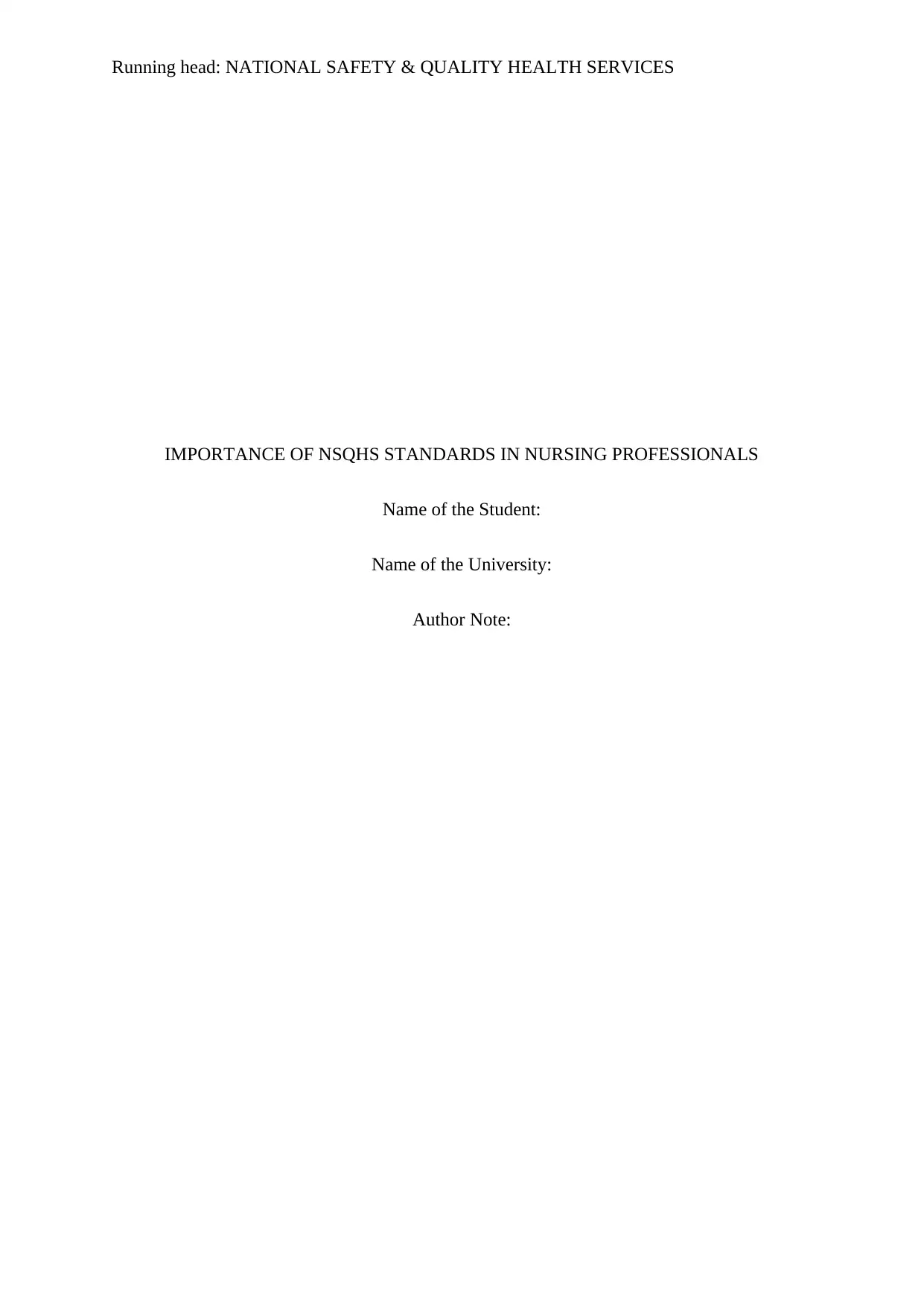
Running head: NATIONAL SAFETY & QUALITY HEALTH SERVICES
IMPORTANCE OF NSQHS STANDARDS IN NURSING PROFESSIONALS
Name of the Student:
Name of the University:
Author Note:
IMPORTANCE OF NSQHS STANDARDS IN NURSING PROFESSIONALS
Name of the Student:
Name of the University:
Author Note:
Secure Best Marks with AI Grader
Need help grading? Try our AI Grader for instant feedback on your assignments.
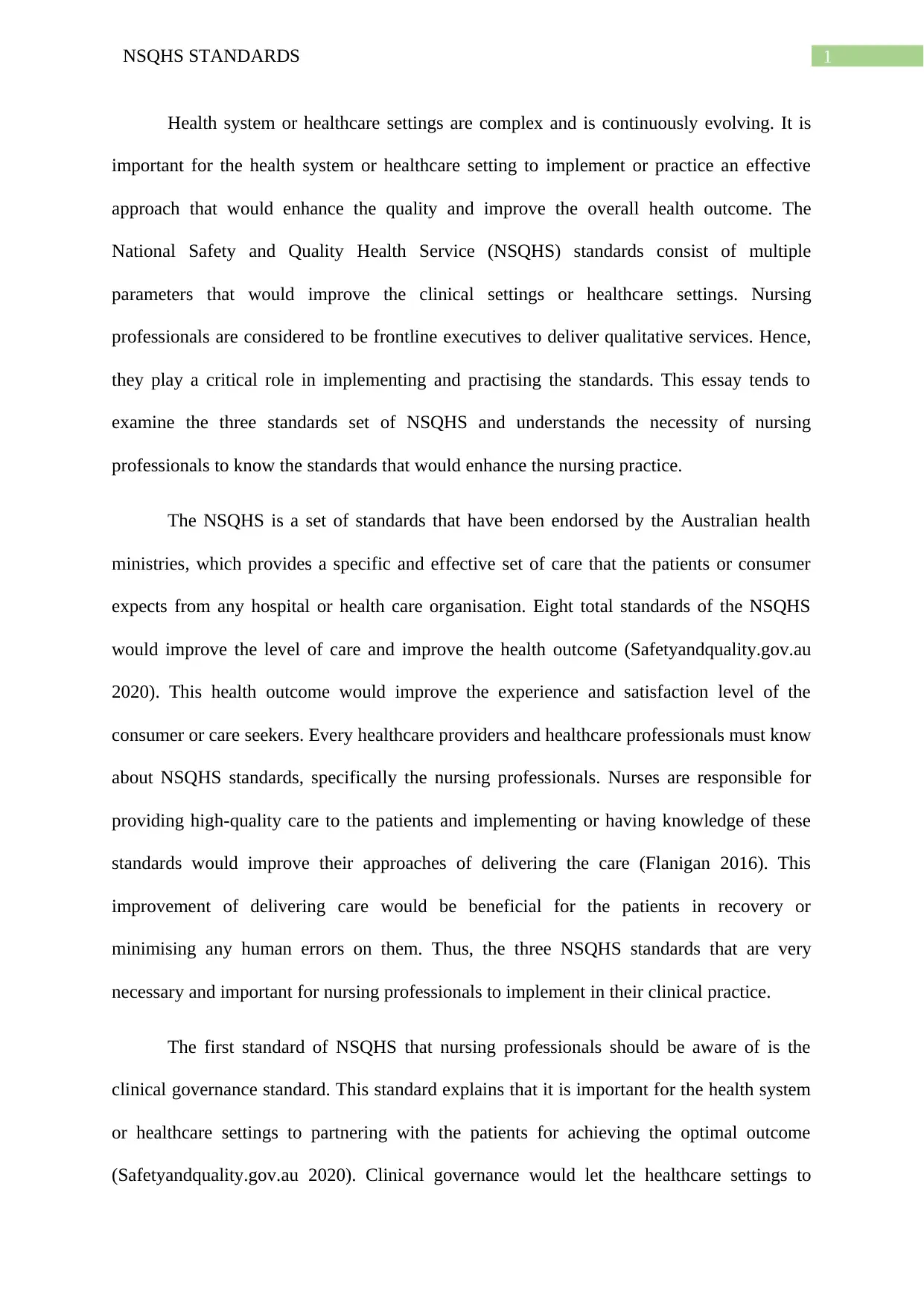
1NSQHS STANDARDS
Health system or healthcare settings are complex and is continuously evolving. It is
important for the health system or healthcare setting to implement or practice an effective
approach that would enhance the quality and improve the overall health outcome. The
National Safety and Quality Health Service (NSQHS) standards consist of multiple
parameters that would improve the clinical settings or healthcare settings. Nursing
professionals are considered to be frontline executives to deliver qualitative services. Hence,
they play a critical role in implementing and practising the standards. This essay tends to
examine the three standards set of NSQHS and understands the necessity of nursing
professionals to know the standards that would enhance the nursing practice.
The NSQHS is a set of standards that have been endorsed by the Australian health
ministries, which provides a specific and effective set of care that the patients or consumer
expects from any hospital or health care organisation. Eight total standards of the NSQHS
would improve the level of care and improve the health outcome (Safetyandquality.gov.au
2020). This health outcome would improve the experience and satisfaction level of the
consumer or care seekers. Every healthcare providers and healthcare professionals must know
about NSQHS standards, specifically the nursing professionals. Nurses are responsible for
providing high-quality care to the patients and implementing or having knowledge of these
standards would improve their approaches of delivering the care (Flanigan 2016). This
improvement of delivering care would be beneficial for the patients in recovery or
minimising any human errors on them. Thus, the three NSQHS standards that are very
necessary and important for nursing professionals to implement in their clinical practice.
The first standard of NSQHS that nursing professionals should be aware of is the
clinical governance standard. This standard explains that it is important for the health system
or healthcare settings to partnering with the patients for achieving the optimal outcome
(Safetyandquality.gov.au 2020). Clinical governance would let the healthcare settings to
Health system or healthcare settings are complex and is continuously evolving. It is
important for the health system or healthcare setting to implement or practice an effective
approach that would enhance the quality and improve the overall health outcome. The
National Safety and Quality Health Service (NSQHS) standards consist of multiple
parameters that would improve the clinical settings or healthcare settings. Nursing
professionals are considered to be frontline executives to deliver qualitative services. Hence,
they play a critical role in implementing and practising the standards. This essay tends to
examine the three standards set of NSQHS and understands the necessity of nursing
professionals to know the standards that would enhance the nursing practice.
The NSQHS is a set of standards that have been endorsed by the Australian health
ministries, which provides a specific and effective set of care that the patients or consumer
expects from any hospital or health care organisation. Eight total standards of the NSQHS
would improve the level of care and improve the health outcome (Safetyandquality.gov.au
2020). This health outcome would improve the experience and satisfaction level of the
consumer or care seekers. Every healthcare providers and healthcare professionals must know
about NSQHS standards, specifically the nursing professionals. Nurses are responsible for
providing high-quality care to the patients and implementing or having knowledge of these
standards would improve their approaches of delivering the care (Flanigan 2016). This
improvement of delivering care would be beneficial for the patients in recovery or
minimising any human errors on them. Thus, the three NSQHS standards that are very
necessary and important for nursing professionals to implement in their clinical practice.
The first standard of NSQHS that nursing professionals should be aware of is the
clinical governance standard. This standard explains that it is important for the health system
or healthcare settings to partnering with the patients for achieving the optimal outcome
(Safetyandquality.gov.au 2020). Clinical governance would let the healthcare settings to
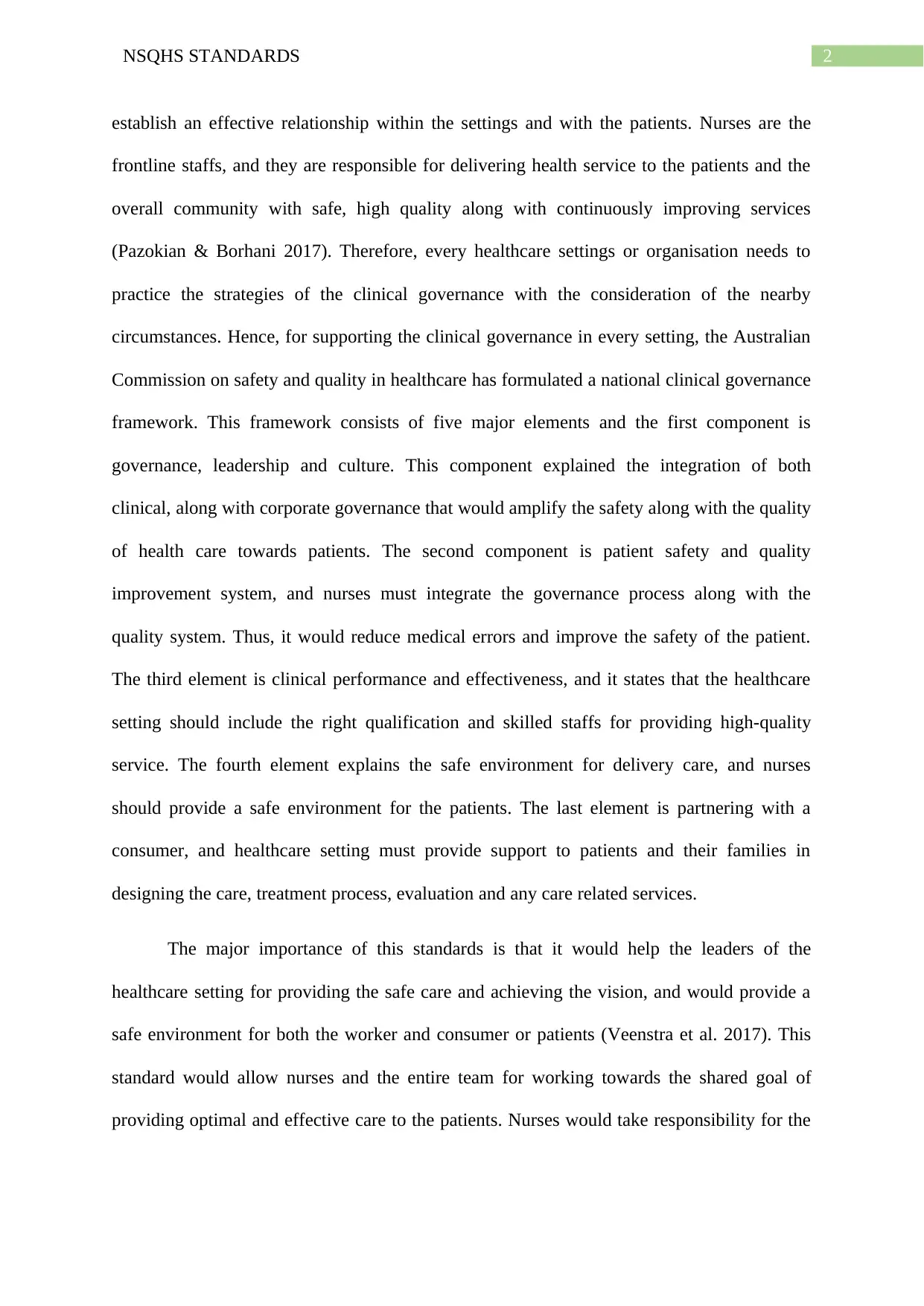
2NSQHS STANDARDS
establish an effective relationship within the settings and with the patients. Nurses are the
frontline staffs, and they are responsible for delivering health service to the patients and the
overall community with safe, high quality along with continuously improving services
(Pazokian & Borhani 2017). Therefore, every healthcare settings or organisation needs to
practice the strategies of the clinical governance with the consideration of the nearby
circumstances. Hence, for supporting the clinical governance in every setting, the Australian
Commission on safety and quality in healthcare has formulated a national clinical governance
framework. This framework consists of five major elements and the first component is
governance, leadership and culture. This component explained the integration of both
clinical, along with corporate governance that would amplify the safety along with the quality
of health care towards patients. The second component is patient safety and quality
improvement system, and nurses must integrate the governance process along with the
quality system. Thus, it would reduce medical errors and improve the safety of the patient.
The third element is clinical performance and effectiveness, and it states that the healthcare
setting should include the right qualification and skilled staffs for providing high-quality
service. The fourth element explains the safe environment for delivery care, and nurses
should provide a safe environment for the patients. The last element is partnering with a
consumer, and healthcare setting must provide support to patients and their families in
designing the care, treatment process, evaluation and any care related services.
The major importance of this standards is that it would help the leaders of the
healthcare setting for providing the safe care and achieving the vision, and would provide a
safe environment for both the worker and consumer or patients (Veenstra et al. 2017). This
standard would allow nurses and the entire team for working towards the shared goal of
providing optimal and effective care to the patients. Nurses would take responsibility for the
establish an effective relationship within the settings and with the patients. Nurses are the
frontline staffs, and they are responsible for delivering health service to the patients and the
overall community with safe, high quality along with continuously improving services
(Pazokian & Borhani 2017). Therefore, every healthcare settings or organisation needs to
practice the strategies of the clinical governance with the consideration of the nearby
circumstances. Hence, for supporting the clinical governance in every setting, the Australian
Commission on safety and quality in healthcare has formulated a national clinical governance
framework. This framework consists of five major elements and the first component is
governance, leadership and culture. This component explained the integration of both
clinical, along with corporate governance that would amplify the safety along with the quality
of health care towards patients. The second component is patient safety and quality
improvement system, and nurses must integrate the governance process along with the
quality system. Thus, it would reduce medical errors and improve the safety of the patient.
The third element is clinical performance and effectiveness, and it states that the healthcare
setting should include the right qualification and skilled staffs for providing high-quality
service. The fourth element explains the safe environment for delivery care, and nurses
should provide a safe environment for the patients. The last element is partnering with a
consumer, and healthcare setting must provide support to patients and their families in
designing the care, treatment process, evaluation and any care related services.
The major importance of this standards is that it would help the leaders of the
healthcare setting for providing the safe care and achieving the vision, and would provide a
safe environment for both the worker and consumer or patients (Veenstra et al. 2017). This
standard would allow nurses and the entire team for working towards the shared goal of
providing optimal and effective care to the patients. Nurses would take responsibility for the
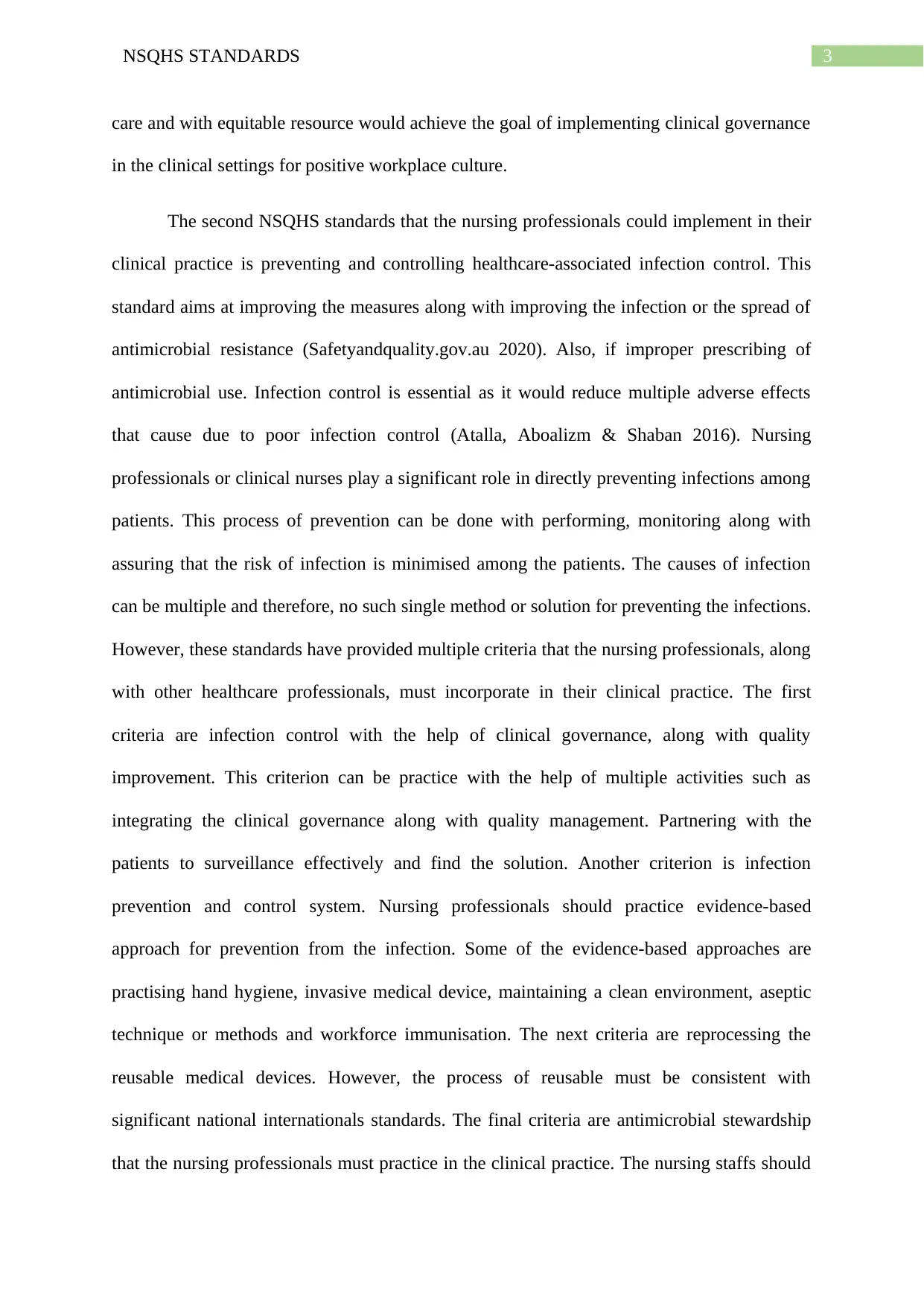
3NSQHS STANDARDS
care and with equitable resource would achieve the goal of implementing clinical governance
in the clinical settings for positive workplace culture.
The second NSQHS standards that the nursing professionals could implement in their
clinical practice is preventing and controlling healthcare-associated infection control. This
standard aims at improving the measures along with improving the infection or the spread of
antimicrobial resistance (Safetyandquality.gov.au 2020). Also, if improper prescribing of
antimicrobial use. Infection control is essential as it would reduce multiple adverse effects
that cause due to poor infection control (Atalla, Aboalizm & Shaban 2016). Nursing
professionals or clinical nurses play a significant role in directly preventing infections among
patients. This process of prevention can be done with performing, monitoring along with
assuring that the risk of infection is minimised among the patients. The causes of infection
can be multiple and therefore, no such single method or solution for preventing the infections.
However, these standards have provided multiple criteria that the nursing professionals, along
with other healthcare professionals, must incorporate in their clinical practice. The first
criteria are infection control with the help of clinical governance, along with quality
improvement. This criterion can be practice with the help of multiple activities such as
integrating the clinical governance along with quality management. Partnering with the
patients to surveillance effectively and find the solution. Another criterion is infection
prevention and control system. Nursing professionals should practice evidence-based
approach for prevention from the infection. Some of the evidence-based approaches are
practising hand hygiene, invasive medical device, maintaining a clean environment, aseptic
technique or methods and workforce immunisation. The next criteria are reprocessing the
reusable medical devices. However, the process of reusable must be consistent with
significant national internationals standards. The final criteria are antimicrobial stewardship
that the nursing professionals must practice in the clinical practice. The nursing staffs should
care and with equitable resource would achieve the goal of implementing clinical governance
in the clinical settings for positive workplace culture.
The second NSQHS standards that the nursing professionals could implement in their
clinical practice is preventing and controlling healthcare-associated infection control. This
standard aims at improving the measures along with improving the infection or the spread of
antimicrobial resistance (Safetyandquality.gov.au 2020). Also, if improper prescribing of
antimicrobial use. Infection control is essential as it would reduce multiple adverse effects
that cause due to poor infection control (Atalla, Aboalizm & Shaban 2016). Nursing
professionals or clinical nurses play a significant role in directly preventing infections among
patients. This process of prevention can be done with performing, monitoring along with
assuring that the risk of infection is minimised among the patients. The causes of infection
can be multiple and therefore, no such single method or solution for preventing the infections.
However, these standards have provided multiple criteria that the nursing professionals, along
with other healthcare professionals, must incorporate in their clinical practice. The first
criteria are infection control with the help of clinical governance, along with quality
improvement. This criterion can be practice with the help of multiple activities such as
integrating the clinical governance along with quality management. Partnering with the
patients to surveillance effectively and find the solution. Another criterion is infection
prevention and control system. Nursing professionals should practice evidence-based
approach for prevention from the infection. Some of the evidence-based approaches are
practising hand hygiene, invasive medical device, maintaining a clean environment, aseptic
technique or methods and workforce immunisation. The next criteria are reprocessing the
reusable medical devices. However, the process of reusable must be consistent with
significant national internationals standards. The final criteria are antimicrobial stewardship
that the nursing professionals must practice in the clinical practice. The nursing staffs should
Secure Best Marks with AI Grader
Need help grading? Try our AI Grader for instant feedback on your assignments.
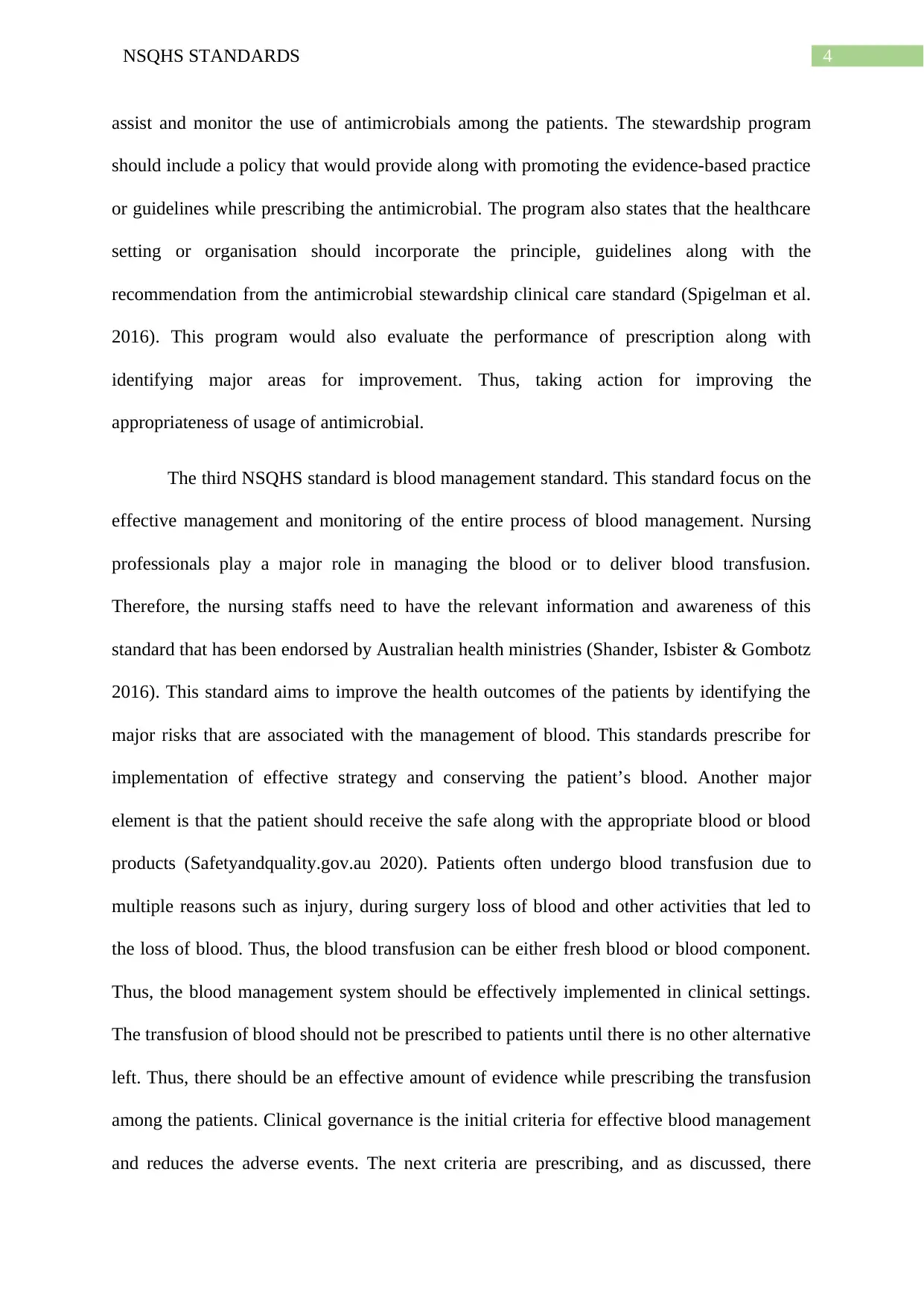
4NSQHS STANDARDS
assist and monitor the use of antimicrobials among the patients. The stewardship program
should include a policy that would provide along with promoting the evidence-based practice
or guidelines while prescribing the antimicrobial. The program also states that the healthcare
setting or organisation should incorporate the principle, guidelines along with the
recommendation from the antimicrobial stewardship clinical care standard (Spigelman et al.
2016). This program would also evaluate the performance of prescription along with
identifying major areas for improvement. Thus, taking action for improving the
appropriateness of usage of antimicrobial.
The third NSQHS standard is blood management standard. This standard focus on the
effective management and monitoring of the entire process of blood management. Nursing
professionals play a major role in managing the blood or to deliver blood transfusion.
Therefore, the nursing staffs need to have the relevant information and awareness of this
standard that has been endorsed by Australian health ministries (Shander, Isbister & Gombotz
2016). This standard aims to improve the health outcomes of the patients by identifying the
major risks that are associated with the management of blood. This standards prescribe for
implementation of effective strategy and conserving the patient’s blood. Another major
element is that the patient should receive the safe along with the appropriate blood or blood
products (Safetyandquality.gov.au 2020). Patients often undergo blood transfusion due to
multiple reasons such as injury, during surgery loss of blood and other activities that led to
the loss of blood. Thus, the blood transfusion can be either fresh blood or blood component.
Thus, the blood management system should be effectively implemented in clinical settings.
The transfusion of blood should not be prescribed to patients until there is no other alternative
left. Thus, there should be an effective amount of evidence while prescribing the transfusion
among the patients. Clinical governance is the initial criteria for effective blood management
and reduces the adverse events. The next criteria are prescribing, and as discussed, there
assist and monitor the use of antimicrobials among the patients. The stewardship program
should include a policy that would provide along with promoting the evidence-based practice
or guidelines while prescribing the antimicrobial. The program also states that the healthcare
setting or organisation should incorporate the principle, guidelines along with the
recommendation from the antimicrobial stewardship clinical care standard (Spigelman et al.
2016). This program would also evaluate the performance of prescription along with
identifying major areas for improvement. Thus, taking action for improving the
appropriateness of usage of antimicrobial.
The third NSQHS standard is blood management standard. This standard focus on the
effective management and monitoring of the entire process of blood management. Nursing
professionals play a major role in managing the blood or to deliver blood transfusion.
Therefore, the nursing staffs need to have the relevant information and awareness of this
standard that has been endorsed by Australian health ministries (Shander, Isbister & Gombotz
2016). This standard aims to improve the health outcomes of the patients by identifying the
major risks that are associated with the management of blood. This standards prescribe for
implementation of effective strategy and conserving the patient’s blood. Another major
element is that the patient should receive the safe along with the appropriate blood or blood
products (Safetyandquality.gov.au 2020). Patients often undergo blood transfusion due to
multiple reasons such as injury, during surgery loss of blood and other activities that led to
the loss of blood. Thus, the blood transfusion can be either fresh blood or blood component.
Thus, the blood management system should be effectively implemented in clinical settings.
The transfusion of blood should not be prescribed to patients until there is no other alternative
left. Thus, there should be an effective amount of evidence while prescribing the transfusion
among the patients. Clinical governance is the initial criteria for effective blood management
and reduces the adverse events. The next criteria are prescribing, and as discussed, there
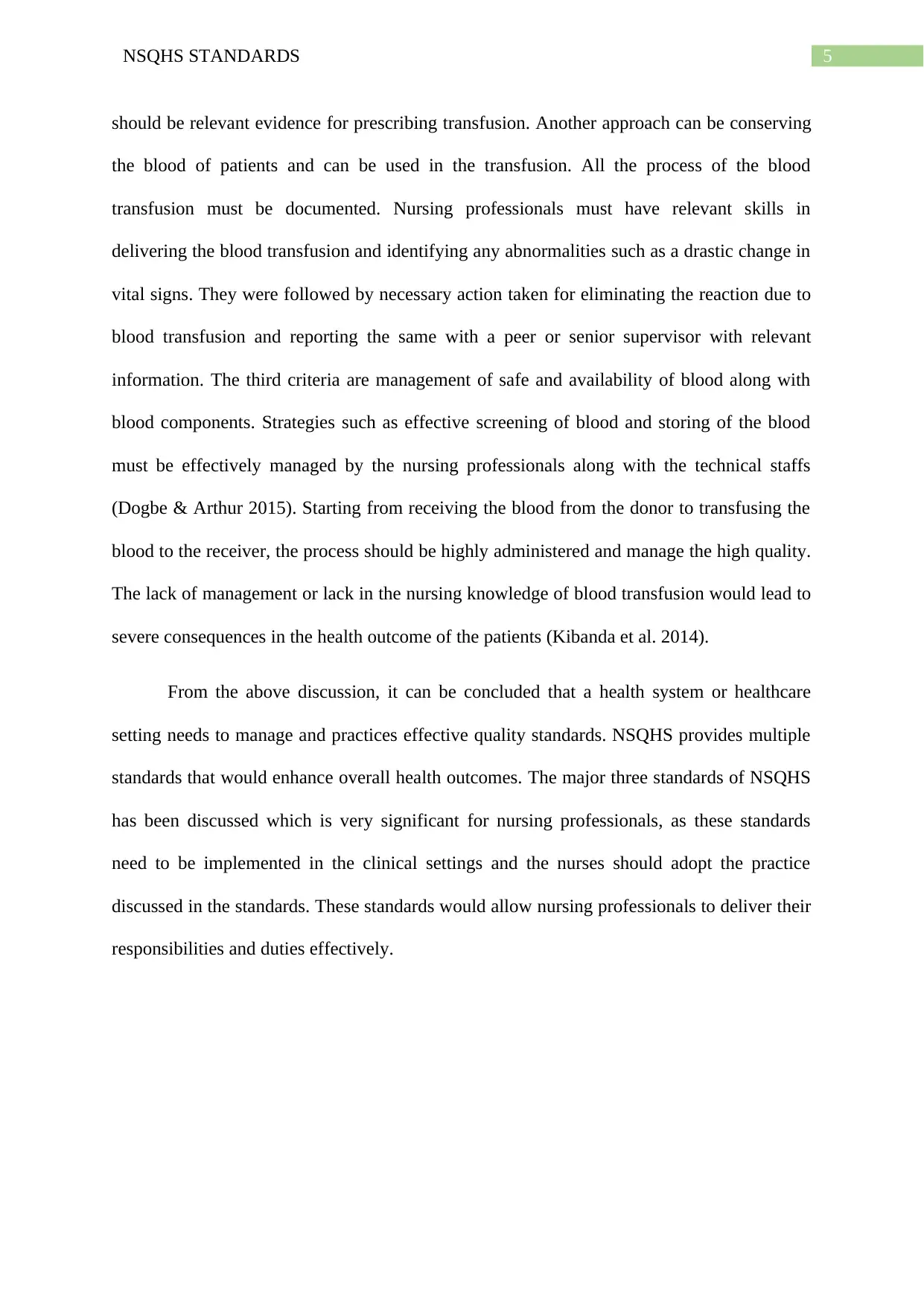
5NSQHS STANDARDS
should be relevant evidence for prescribing transfusion. Another approach can be conserving
the blood of patients and can be used in the transfusion. All the process of the blood
transfusion must be documented. Nursing professionals must have relevant skills in
delivering the blood transfusion and identifying any abnormalities such as a drastic change in
vital signs. They were followed by necessary action taken for eliminating the reaction due to
blood transfusion and reporting the same with a peer or senior supervisor with relevant
information. The third criteria are management of safe and availability of blood along with
blood components. Strategies such as effective screening of blood and storing of the blood
must be effectively managed by the nursing professionals along with the technical staffs
(Dogbe & Arthur 2015). Starting from receiving the blood from the donor to transfusing the
blood to the receiver, the process should be highly administered and manage the high quality.
The lack of management or lack in the nursing knowledge of blood transfusion would lead to
severe consequences in the health outcome of the patients (Kibanda et al. 2014).
From the above discussion, it can be concluded that a health system or healthcare
setting needs to manage and practices effective quality standards. NSQHS provides multiple
standards that would enhance overall health outcomes. The major three standards of NSQHS
has been discussed which is very significant for nursing professionals, as these standards
need to be implemented in the clinical settings and the nurses should adopt the practice
discussed in the standards. These standards would allow nursing professionals to deliver their
responsibilities and duties effectively.
should be relevant evidence for prescribing transfusion. Another approach can be conserving
the blood of patients and can be used in the transfusion. All the process of the blood
transfusion must be documented. Nursing professionals must have relevant skills in
delivering the blood transfusion and identifying any abnormalities such as a drastic change in
vital signs. They were followed by necessary action taken for eliminating the reaction due to
blood transfusion and reporting the same with a peer or senior supervisor with relevant
information. The third criteria are management of safe and availability of blood along with
blood components. Strategies such as effective screening of blood and storing of the blood
must be effectively managed by the nursing professionals along with the technical staffs
(Dogbe & Arthur 2015). Starting from receiving the blood from the donor to transfusing the
blood to the receiver, the process should be highly administered and manage the high quality.
The lack of management or lack in the nursing knowledge of blood transfusion would lead to
severe consequences in the health outcome of the patients (Kibanda et al. 2014).
From the above discussion, it can be concluded that a health system or healthcare
setting needs to manage and practices effective quality standards. NSQHS provides multiple
standards that would enhance overall health outcomes. The major three standards of NSQHS
has been discussed which is very significant for nursing professionals, as these standards
need to be implemented in the clinical settings and the nurses should adopt the practice
discussed in the standards. These standards would allow nursing professionals to deliver their
responsibilities and duties effectively.
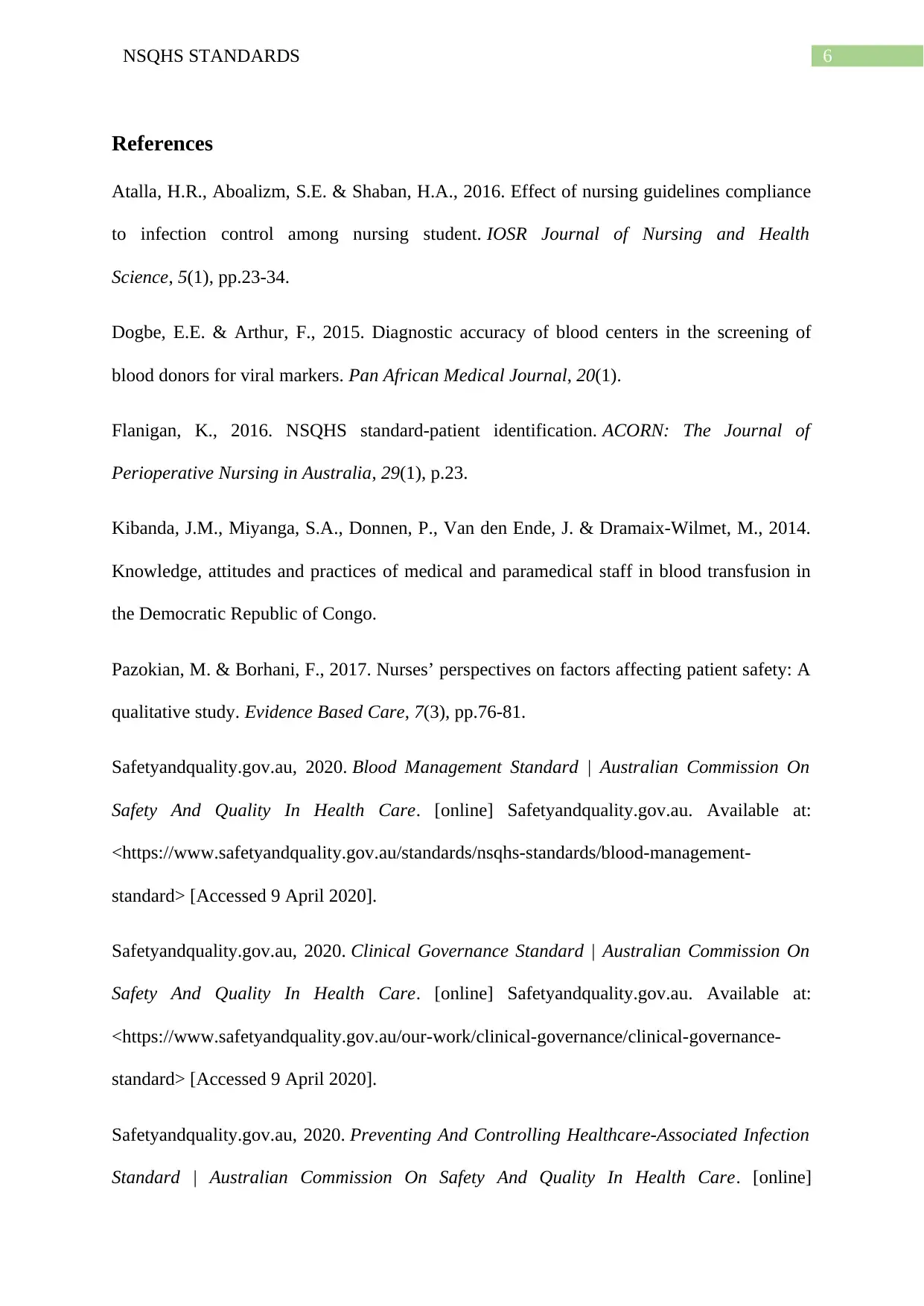
6NSQHS STANDARDS
References
Atalla, H.R., Aboalizm, S.E. & Shaban, H.A., 2016. Effect of nursing guidelines compliance
to infection control among nursing student. IOSR Journal of Nursing and Health
Science, 5(1), pp.23-34.
Dogbe, E.E. & Arthur, F., 2015. Diagnostic accuracy of blood centers in the screening of
blood donors for viral markers. Pan African Medical Journal, 20(1).
Flanigan, K., 2016. NSQHS standard-patient identification. ACORN: The Journal of
Perioperative Nursing in Australia, 29(1), p.23.
Kibanda, J.M., Miyanga, S.A., Donnen, P., Van den Ende, J. & Dramaix-Wilmet, M., 2014.
Knowledge, attitudes and practices of medical and paramedical staff in blood transfusion in
the Democratic Republic of Congo.
Pazokian, M. & Borhani, F., 2017. Nurses’ perspectives on factors affecting patient safety: A
qualitative study. Evidence Based Care, 7(3), pp.76-81.
Safetyandquality.gov.au, 2020. Blood Management Standard | Australian Commission On
Safety And Quality In Health Care. [online] Safetyandquality.gov.au. Available at:
<https://www.safetyandquality.gov.au/standards/nsqhs-standards/blood-management-
standard> [Accessed 9 April 2020].
Safetyandquality.gov.au, 2020. Clinical Governance Standard | Australian Commission On
Safety And Quality In Health Care. [online] Safetyandquality.gov.au. Available at:
<https://www.safetyandquality.gov.au/our-work/clinical-governance/clinical-governance-
standard> [Accessed 9 April 2020].
Safetyandquality.gov.au, 2020. Preventing And Controlling Healthcare-Associated Infection
Standard | Australian Commission On Safety And Quality In Health Care. [online]
References
Atalla, H.R., Aboalizm, S.E. & Shaban, H.A., 2016. Effect of nursing guidelines compliance
to infection control among nursing student. IOSR Journal of Nursing and Health
Science, 5(1), pp.23-34.
Dogbe, E.E. & Arthur, F., 2015. Diagnostic accuracy of blood centers in the screening of
blood donors for viral markers. Pan African Medical Journal, 20(1).
Flanigan, K., 2016. NSQHS standard-patient identification. ACORN: The Journal of
Perioperative Nursing in Australia, 29(1), p.23.
Kibanda, J.M., Miyanga, S.A., Donnen, P., Van den Ende, J. & Dramaix-Wilmet, M., 2014.
Knowledge, attitudes and practices of medical and paramedical staff in blood transfusion in
the Democratic Republic of Congo.
Pazokian, M. & Borhani, F., 2017. Nurses’ perspectives on factors affecting patient safety: A
qualitative study. Evidence Based Care, 7(3), pp.76-81.
Safetyandquality.gov.au, 2020. Blood Management Standard | Australian Commission On
Safety And Quality In Health Care. [online] Safetyandquality.gov.au. Available at:
<https://www.safetyandquality.gov.au/standards/nsqhs-standards/blood-management-
standard> [Accessed 9 April 2020].
Safetyandquality.gov.au, 2020. Clinical Governance Standard | Australian Commission On
Safety And Quality In Health Care. [online] Safetyandquality.gov.au. Available at:
<https://www.safetyandquality.gov.au/our-work/clinical-governance/clinical-governance-
standard> [Accessed 9 April 2020].
Safetyandquality.gov.au, 2020. Preventing And Controlling Healthcare-Associated Infection
Standard | Australian Commission On Safety And Quality In Health Care. [online]
Paraphrase This Document
Need a fresh take? Get an instant paraphrase of this document with our AI Paraphraser
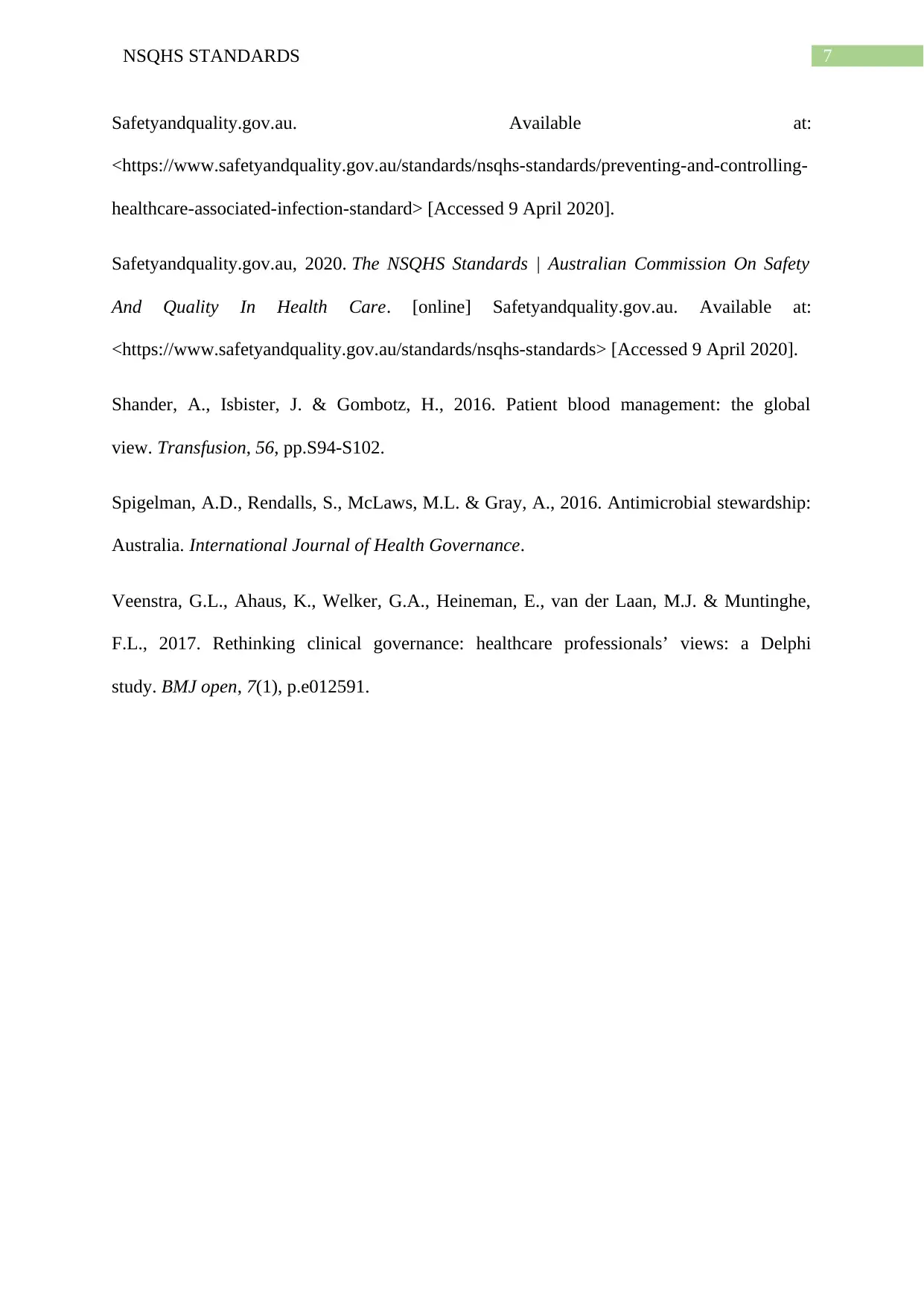
7NSQHS STANDARDS
Safetyandquality.gov.au. Available at:
<https://www.safetyandquality.gov.au/standards/nsqhs-standards/preventing-and-controlling-
healthcare-associated-infection-standard> [Accessed 9 April 2020].
Safetyandquality.gov.au, 2020. The NSQHS Standards | Australian Commission On Safety
And Quality In Health Care. [online] Safetyandquality.gov.au. Available at:
<https://www.safetyandquality.gov.au/standards/nsqhs-standards> [Accessed 9 April 2020].
Shander, A., Isbister, J. & Gombotz, H., 2016. Patient blood management: the global
view. Transfusion, 56, pp.S94-S102.
Spigelman, A.D., Rendalls, S., McLaws, M.L. & Gray, A., 2016. Antimicrobial stewardship:
Australia. International Journal of Health Governance.
Veenstra, G.L., Ahaus, K., Welker, G.A., Heineman, E., van der Laan, M.J. & Muntinghe,
F.L., 2017. Rethinking clinical governance: healthcare professionals’ views: a Delphi
study. BMJ open, 7(1), p.e012591.
Safetyandquality.gov.au. Available at:
<https://www.safetyandquality.gov.au/standards/nsqhs-standards/preventing-and-controlling-
healthcare-associated-infection-standard> [Accessed 9 April 2020].
Safetyandquality.gov.au, 2020. The NSQHS Standards | Australian Commission On Safety
And Quality In Health Care. [online] Safetyandquality.gov.au. Available at:
<https://www.safetyandquality.gov.au/standards/nsqhs-standards> [Accessed 9 April 2020].
Shander, A., Isbister, J. & Gombotz, H., 2016. Patient blood management: the global
view. Transfusion, 56, pp.S94-S102.
Spigelman, A.D., Rendalls, S., McLaws, M.L. & Gray, A., 2016. Antimicrobial stewardship:
Australia. International Journal of Health Governance.
Veenstra, G.L., Ahaus, K., Welker, G.A., Heineman, E., van der Laan, M.J. & Muntinghe,
F.L., 2017. Rethinking clinical governance: healthcare professionals’ views: a Delphi
study. BMJ open, 7(1), p.e012591.
1 out of 8
Related Documents
Your All-in-One AI-Powered Toolkit for Academic Success.
+13062052269
info@desklib.com
Available 24*7 on WhatsApp / Email
![[object Object]](/_next/static/media/star-bottom.7253800d.svg)
Unlock your academic potential
© 2024 | Zucol Services PVT LTD | All rights reserved.





